Stonehenge a New Understanding (56 page)
Read Stonehenge a New Understanding Online
Authors: Mike Parker Pearson
Tags: #Social Science, #Archaeology

Reconstruction of Bluestonehenge at West Amesbury, on the west bank of the River Avon.
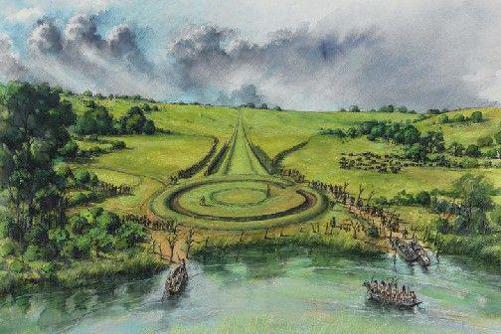
Reconstruction of the Stonehenge Avenue reaching the West Amesbury henge after removal of the bluestones and construction of a henge bank and ditch.
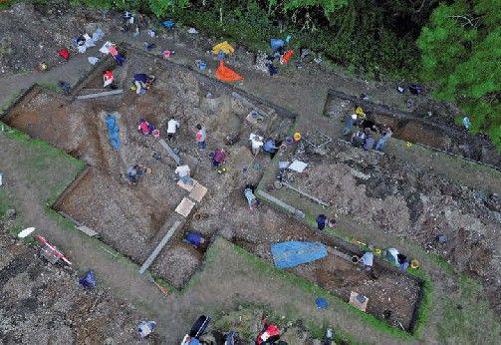
The busy moments of an excavation. This is Bluestonehenge in 2009.
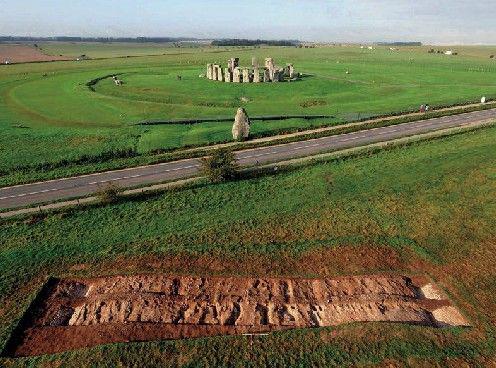
The periglacial stripes and chalk ridges revealed in our excavation across the avenue close to Stonehenge in 2008.
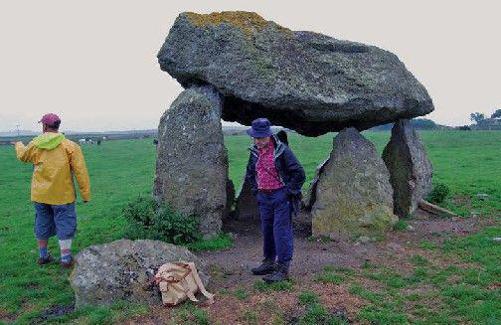
Colin Richards (left) and Andrew Chamberlain at the closed chamber tomb, or cromlech, of Carreg Samson in west Wales.
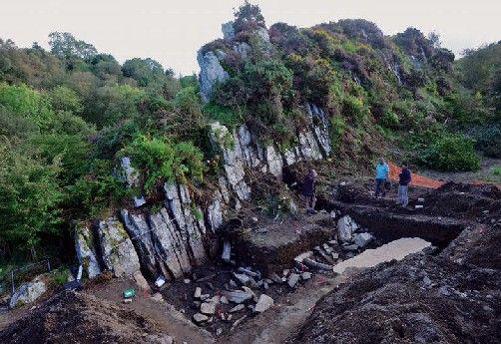
ACKNOWLEDGMENTSAt Craig Rhosyfelin, we found the first clear evidence of bluestone quarrying. The monolith (lower right) left behind in the quarry was detached by prehistoric stoneworkers from the outcrop (behind where Ben Chan and I are standing); they then moved the monolith from the rock face along stone rails, on which it still rests.
__________
My codirectors of the Stonehenge Riverside Project were Josh Pollard, Chris Tilley, Julian Thomas, Colin Richards, and Kate Welham. We were joined for specific projects in later years by Mike Allen, Wayne Bennett, Charly French, Chris Gaffney, Paul Garwood, Jacqui McKinley, Mike Pitts, Julian Richards, (California) Dave Robinson, Clive Ruggles, Rob Scaife, and Armin Schmidt. The long excavation seasons were made possible by the team of supervisors—Becca Pullen, Hugo Anderson-Whymark, (Manchester) Dave Aspden, Ben Chan, Ian Heath, Neil Morris, Bob Nunn, Jim Rylatt, Ellen Simmons, and Anne Teather—who were joined by many hard-working site assistants each year. Amongst these, I need to mention Lizzie Carleton, Chris Caswell, Ralph Collard, C. J. Hyde, (Farmer) Dave Shaw, Susan Stratton, and James Thomson, who started as novice undergraduate diggers and ended up training others.
The geophysical surveys and data processing depended on Mark Dover, who managed the digital resource throughout the first stage of the project; from among the many Bournemouth students who undertook the surveys, Lawrence Shaw and Charlene Steele continue to work on aspects of the project. All of the above, especially Hugo, also contributed to the success of some indescribable campsite parties, for which Alistair Pike provided glow-sticks; I imagine there are photographs on Facebook, but I have never dared look.
The student diggers came primarily from the universities of Sheffield, Manchester, Bournemouth, UCLAN, Birmingham, Cardiff, Kalmar, Leicester, Exeter, Plymouth, and UCL: They cannot be named individually of course, because we probably trained over five hundred undergraduates over the life of the project. As is usual with archaeology students on excavations, the majority enjoyed themselves enormously, a handful appeared to hate the whole experience, and a lucky few came back for more year
after year. Some of the students took part in visitor guiding and public outreach, an integral part of a project such as this, managed by Megan and David Price, and then by Pat Shelley. Adam Stanford of Aerial-Cam took many essential—and stunning—photographs throughout the project. Helen Wickstead coordinated the artists in residence, who are thanked for bringing a new dimension to the project.
The main staffing problem in the later years of the project was having to turn people away—we could never accommodate everyone who wanted to volunteer. For those who did, I again cannot mention all by name, but Jane Downes, Duncan Brown, Denise Allen, Win Scutt, David Durkin, and all the other volunteers know that their work was much appreciated. Three important volunteers throughout the project’s life have been Eileen Parker, Lesley Chapman, and Jane Ford, all mature students of archaeology in Sheffield, who continue to dedicate their time, patience, and skills to the post-excavation process.
All the landowners and tenant farmers were unfailingly helpful and patient, allowing us access to the sites, sometimes over several seasons: We owe a debt of thanks to Sir Edward Antrobus, Richard Bawden, Ian Baxter, Stuart Crook, Mr. E. Hann, Billy King, Hugh Morrison, Stan and Henry Rawlins, the Rowlands, and Rob Turner in Wiltshire, and Huw Davies, the late Iorwerth Williams, and the late Hyacinthe Hawkesworth, Lady Marcher of Cemaes, in Pembrokeshire. Chris Gingell and Martin Papworth ran the National Trust side of the necessary permissions, and Amanda Chadburn and Rachel Foster of English Heritage had the unsung task of managing all the paperwork and meetings generated by our research proposals every year; English Heritage also funded two seasons of visitor outreach, coordinated by Kath Graham and Lerato Dunn. Dave Field and Martyn Barber at English Heritage have been endlessly helpful and willing to share their research ideas. MoD archaeologists Richard Osgood and Martin Brown are thanked for making arrangements for work on Royal School of Artillery land.
Thanks go to Wessex Archaeology for providing equipment, and support for the flotation program. Reg Jury provided mechanical excavators, some huge trout, and an enormously generous contribution to the diggers’ beer fund. The Woodbridge Inn in North Newnton housed us every year, the Masseys provided an essential ex-Army tent, and Rushall
Village Hall and Corsham Scouts helped out with domestic equipment. Archaeological projects rely on such local goodwill, and we are tremendously grateful to all concerned.
We also rely on our funding bodies who, we hope, are pleased with the results of this project that they supported for so many years. The major project funder was the Arts and Humanities Research Council, with further grants and awards for different aspects of the overall project provided by the National Geographic Society, the British Academy, the Royal Archaeological Institute, the Society of Antiquaries, Google, the Robert Kiln Trust, Andante Travel, and the Royal Society of Northern Antiquaries of Copenhagen. Naomi Nathan, Jo Mirfield, and Chris Grimbley in Sheffield were driven to distraction at times by the problems of administering these multiple grants, and Karen and I thank them for their patience in helping sort out our bundles of muddy, dog-eared receipts every year, and in putting together our hired vans and fieldwork equipment.
My director’s site diary will end up in the project archive at some point in the future; as well as recording the technical details of what was happening on site each day, it often mentions visitors to the excavations. We were encouraged and heartened by the interest that other archaeologists took in our work, and it was a pleasure to have so many come to visit the sites. I think we managed to prove that a multi-director team was not just feasible but genuinely productive, especially since we are still working together.
For their archaeological advice or other contributions, I particularly wish to thank Louise Austin, Jenny and Bill Britnell, Dave Buckley, Tim Darvill, Peter Drewett, Julie Gardiner, Alex Gibson, Mark Gillings, Phil Harding, Mats Larsson, Ben Laurie, Neil Linford, Andy Payne, Alison Sheridan, Paul Tubb, and Geoff Wainwright. In addition, a large team of specialists—too numerous to list here—continues to work on the post-excavation aspects of the project.
My wife Karen has been in the background, managing the project, from its inception, and has dealt with everything from van-driving and fancy-dress outfits to sewage disposal and impetigo, as well as taking on time-consuming post-excavation tasks back in Sheffield. As she spent each summer cooking for hundreds of people, she rarely had time to see
the excavations in action, so her editing work on this and all past and future project publications is her chance to finally see what we found out (or so I keep telling her, as I hand her yet another draft . . .).
The new illustrations prepared for this book are by Peter Dunn (several of them being sponsored by Pat Shelley’s Salisbury & Stonehenge Guided Tours), and Irene de Luis.
Bill Hamilton of A. M. Heath & Co., Monica O’Connell, and Mike Jones of Simon & Schuster brought the book to publication.
__________
INTRODUCTION
1
. Wim van Es, cited in Bakker 1999: 9.
1
. Cleal
et al
. 1995: 154–5, 451–61.
2
. Wainwright with Longworth 1971.
3
. Cleal
et al
. 1995: 291–329.
4
. Burl 2002; Gillings
et al
. 2008; Pollard and Gillings 2004.
5
. Whittle 1997a.
6
. Parker Pearson and Ramilisonina 1998a.
7
. Durrani 2009.
8
. Flinders Petrie 1880: 31.
9
. Evans 1885.
10
. Burl 1987.
11
. Bender 1998; Whittle 1997b.
12
. Barrett and Fewster 1998; Whitley 2002.
13
. Parker Pearson and Ramilisonina 1998b.
14
. Spindler 1995; Walton and Wild 1990.
15
. Barker 2009.
16
. Larson
et al
. 2007; Edwards
et al
. 2010.
